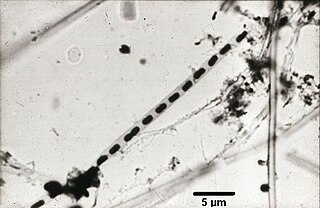
The Comamonadaceae are a family of the Betaproteobacteria. Like all Pseudomonadota, they are Gram-negative. They are aerobic and most of the species are motile via flagella. The cells are curved rod-shaped.
Oceanospirillaceae is a family of Pseudomonadota. Most genera in this family live in environments with high concentrations of salt; they are halotolerant or halophilic. They are marine, except Balneatrix which is found in fresh water and Venatorbacter, which is from terrestrial origin.All members are strictly aerobic, except Neptunomonas which can perform fermentation reactions.
The Lachnospiraceae are a family of obligately anaerobic, variably spore-forming bacteria in the order Eubacteriales that ferment diverse plant polysaccharides to short-chain fatty acids and alcohols (ethanol). These bacteria are among the most abundant taxa in the rumen and the human gut microbiota. Members of this family may protect against colon cancer in humans by producing butyric acid. Lachnospiraceae have been found to contribute to diabetes in genetically susceptible (ob/ob) germ-free mice.
Parapedobacter is a genus from the family of Sphingobacteriaceae.
Desulfonema is a Gram-negative bacteria genus from the family Desulfococcaceae.
Marinomonas is an aerobic bacteria genus from the family of Oceanospirillaceae.
Dorea is a Gram-positive and nonspore-forming bacterial genus from the family Lachnospiraceae, which occur in human faeces.
Frigoribacterium is a Gram-positive, non-spore-forming and motile genus of bacteria from the family of Microbacteriaceae.
Bergeriella is a genus of bacteria from the family of Neisseriaceae with one known species. Bergeriella denitrificans has been isolated from the oral mucosa of a rat.
The Dermatophilaceae is a Gram-positive family of bacteria placed within the order of Actinomycetales. Dermatophilaceae bacteria occur on animal and human skin and in fish guts.
The Hahellaceae are a family of Pseudomonadota in the order of Oceanospirillales.
Allohahella antarctica is a Gram-negative, psychrotolerant, aerobic and chemoheterotrophic bacterium from the genus of Allohahella which has been isolated from seawater from the Antarctic.
Hahella chejuensis is a Gram-negative, aerobic, rod-shaped and motile bacterium from the genus of Hahella which has been isolated from Marado in Korea.
Arenimonas is a genus of Pseudomonadota from the family Xanthomonadaceae.
Singulisphaera is a moderately acidophilic and mesophilic genus of bacteria from the family of Planctomycetaceae.
Thermanaerovibrio is a Gram-negative, non-spore-forming chemoorganotrophic and thermophilic genus of bacteria from the family of Synergistaceae.
Serinibacter is a Gram-positive, non-spore-forming and non-motile genus of bacteria from the family of Beutenbergiaceae.
Terrimonas is a Gram-negative, aerobic and non-motile genus of bacteria from the family of Chitinophagaceae.
Thiorhodococcus is a Gram-negative genus of bacteria from the family of Chromatiaceae.
Oceanimonas baumannii is a Gram-negative and motile bacterium from the genus of Oceanimonas which has been isolated from estuarine mud from the River Wear in England.
